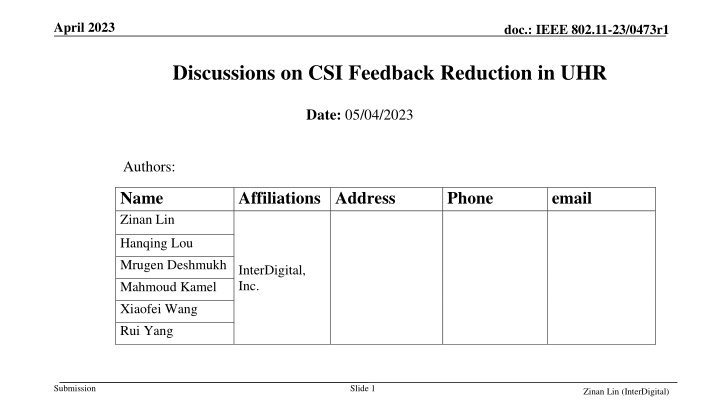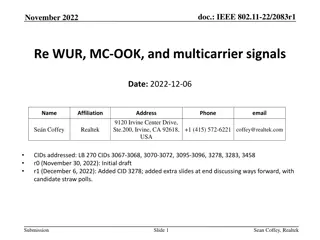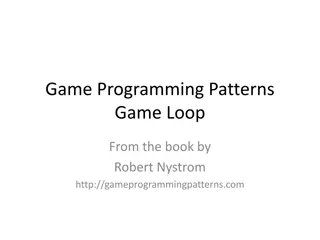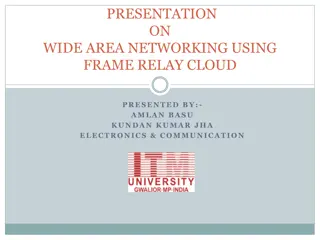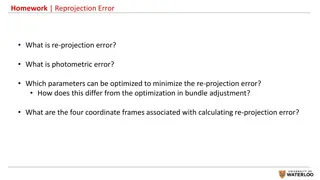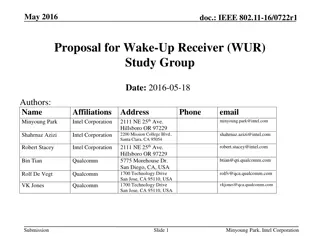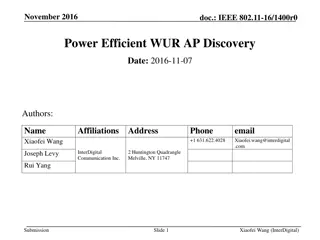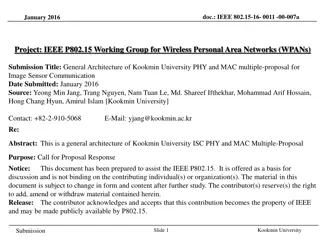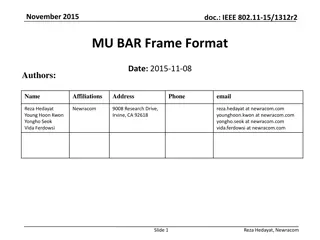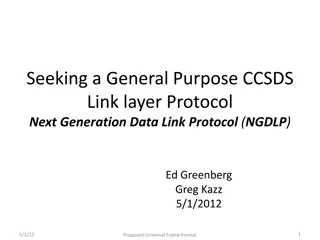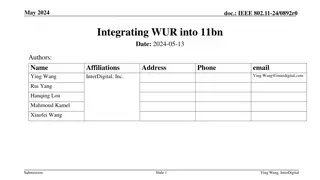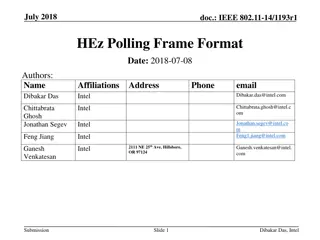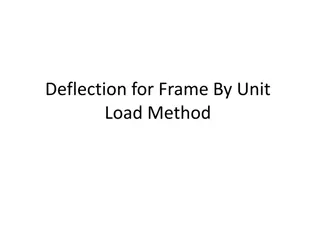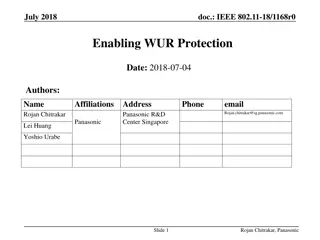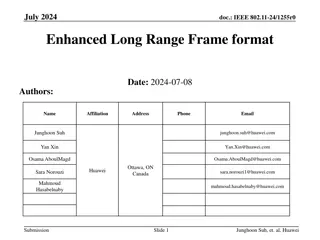Further Considerations on WUR Frame Format Explained
This document delves into the detailed specifications of the Wake-Up Radio (WUR) frame format in IEEE 802.11 standard, covering aspects such as frame control, addressing fields, WUR identifier (WID), and implications for unicast, multicast, and broadcast communications. Additionally, it discusses the use of WID, Group ID (GID), and TXID in different wake-up scenarios, ensuring proper transmission handling for various addressing types.
Download Presentation

Please find below an Image/Link to download the presentation.
The content on the website is provided AS IS for your information and personal use only. It may not be sold, licensed, or shared on other websites without obtaining consent from the author.If you encounter any issues during the download, it is possible that the publisher has removed the file from their server.
You are allowed to download the files provided on this website for personal or commercial use, subject to the condition that they are used lawfully. All files are the property of their respective owners.
The content on the website is provided AS IS for your information and personal use only. It may not be sold, licensed, or shared on other websites without obtaining consent from the author.
E N D
Presentation Transcript
April 2023 doc.: IEEE 802.11-23/0473r1 Discussions on CSI Feedback Reduction in UHR Date: 05/04/2023 Authors: Name Zinan Lin Affiliations Address Phone email Hanqing Lou Mrugen Deshmukh Mahmoud Kamel Xiaofei Wang Rui Yang InterDigital, Inc. Submission Slide 1 Zinan Lin (InterDigital)
April 2023 doc.: IEEE 802.11-23/0473r1 Abstract In this contribution, we discuss the need to reduce the overhead of Channel State Information (CSI) feedback for UHR and the potential methods of CSI feedback reduction. Submission Slide 2 Zinan Lin (InterDigital)
April 2023 doc.: IEEE 802.11-23/0473r1 Introduction Potential features proposed for UHR may require high CSI feedback overhead Multi-AP: joint transmission/coordinated beamforming [2-5] Beamformed MIMO with a large number of antennas up to 16 SS at the AP [6-8] Larger number of antennas at STA [10] Large operating bandwidths (>= 320 MHz) [9] Any combined solutions [9] may further increase the airtime of CSI feedback transmission Large CSI feedback overhead may: Limit the throughput improvement Prolong the delivery of low latency traffic Submission Slide 3 Zinan Lin (InterDigital)
April 2023 doc.: IEEE 802.11-23/0473r1 CSI Overhead Analysis Number of Compressed Beamforming Feedback Bits for 20 MHz SU-MIMO Reports, Ng = 4 Number of Compressed Beamforming Feedback Bits for 20 MHzMU-MIMO Reports, Ng = 4 30240 48384 23520 # of Bits # of Bits 37632 16240 25984 12320 19712 10080 16128 8400 13440 7280 11648 6272 3920 1 2 3 4 1 2 3 4 Nc Nc 8 Tx Antennas 16 Tx Antennas 8 Tx Antennas 16 Tx Antennas The required CSI airtime may be further increased by the large operational bandwidth, high number of STAs associated with one AP (e.g., dense Wi-Fi deployment), MAP joint transmission and coordinated beamforming, etc. Submission Slide 4 Zinan Lin (InterDigital)
April 2023 doc.: IEEE 802.11-23/0473r1 Benefits of Reduced CSI Feedback Overhead Reduce the airtime of CSI feedback transmission and potentially improve the system throughput Enable faster packet delivery with a shortened channel access time, especially for low latency traffic Lessen the burden of frequent sounding sequences for CSI accuracy required in a more dynamic channel environment Submission Slide 5 Zinan Lin (InterDigital)
April 2023 Recap: CSI Feedback Reduction Schemes Proposed in EHT and AIML (1/2) doc.: IEEE 802.11-23/0473r1 The following directions to reduce the CSI feedback are discussed in the existing specs, EHT, AIML proposals Category Specs or Doc Techniques Existing standards 802.11 ac/ax, Apply Givens rotation to decompose V vector and feedback the vector that contains angles (? and ) indices 802.11ah similar technology but allow partial report (? only feedback ) EHT/802.11be proposals: Enhancement of 802.11ax using conventional wireless technologies 19/1018 Decompose the singular vector ? = ?1?2, ?1is reported per subband and ?2 is reported per subcarrier group, where ?2 s dimension is smaller than ? s and dimensions of ?1and ?2 can be parameterized Enable mixed beamforming report: decompose each subcarrier report ?? into wideband report ?W? and narrow band report ???, where ?? :? ?,?W?:? ? , ???:? ??? 19/1115 Submission Slide 6 Zinan Lin (InterDigital)
April 2023 Recap: CSI Feedback Reduction Schemes Proposed in EHT and AIML (2/2) doc.: IEEE 802.11-23/0473r1 Category Specs or Doc Techniques AIML TIG proposals: Enhancement of Compressed CSI feedback 22/1563 Apply K-mean on the angle index vectors and obtain a CSI candidate set in terms of angle vectors; feedback the index of the angle vector among the candidate set 23/0275 Two schemes: 1.Apply K-mean on the vectors containing either ? or ? and obtain the CSI candidate sets (codebooks): two indices per one CSI subcarrier report 2.Apply K-mean on the steering matrices: one index for one subcarrier CSI report 23/0280 Using the basic concept in 19/1018, apply K-mean on ?1 s to obtain ?1codebook; feedback the codebook index of ?1 and the angle vector for ?2(Given s rotation is applied on ?2) 23/290r0 Apply VQ-VAE on V vectors and obtain CSI codebook; feedback the codebook index per CSI report Submission Slide 7 Zinan Lin (InterDigital)
April 2023 doc.: IEEE 802.11-23/0473r1 Challenges of Reducing CSI Feedback Contributions (slides 6 and 7) indicate that the throughput may be boosted by the significantly reduced CSI feedback overhead. However, further compressed CSI feedback may lead to degraded PER performance compared with the current CSI compressed algorithm used in 802.11ax/be for the same MCS Some proposed CSI feedback reduction schemes may be applicable to the use case which requires high throughput but have less restriction on PER performance CSI feedback reduction schemes may be particularly beneficial to the small packet delivery Multiple aspects need to be considered and balanced in CSI reduction schemes: Complexity of generating reduced CSI overhead schemes vs. CSI accuracy Delay reduction as a result of reduced CSI feedback overhead vs. CSI accuracy Sounding procedure frequency vs. CSI accuracy Submission Slide 8 Zinan Lin (InterDigital)
April 2023 doc.: IEEE 802.11-23/0473r1 One Possible Solution Reuse the existing partial feedback in 802.11ah: ? only feedback Extend the 802.11ah feedback schemes to the cases with ?? 1 50%-tile values do not change with different ?? ??settings AP may only need to have one set of 50%-tile values for a given channel condition values may be static or semi-statically changed Depends on the channel condition May be used as an additional CSI reporting option Benefits: CSI feedback overhead is reduced For example, the number of the CSI feedback bits for 8 x 2 MIMO is reduced by 40% if no is reported Simple implementation and no change on the current CSI feedback generation algorithm Coexistence with the legacy CSI feedback algorithm is not a problem foreseen The STA that uses ? only feedback may fall back to the legacy CSI reporting algorithm easily Submission Slide 9 Zinan Lin (InterDigital)
April 2023 doc.: IEEE 802.11-23/0473r1 Simulation assumptions: Channel A-E Sim. for 1000 packets for each channel type 50%-tile ? values do not change with MIMO setting significantly: AP may pre-store the vector of 50%-tile ? values Submission Slide 10 Zinan Lin (InterDigital)
April 2023 doc.: IEEE 802.11-23/0473r1 PER Performance of ? only feedback Simulation Assumptions: 8x2, Channel D, 20 MHz BW Payload length: 1000 bytes Baseline: ? 6 bits, ? 4 bits ?only feedback: 50%-tile ? values used in the beamformer side At lower MCS, e.g. MCS = 0, no PER performance difference between baseline and ? only feedback schemes As MCS increases, the PER performance gap between baseline and ? only feedback schemes increases Less than 1 dB SNR degradation to meet the PER target of 10^(-2) However, ?only feedback scheme results in a significant overhead reduction, i.e., 40% feedback bits reduction Submission Slide 11 Zinan Lin (InterDigital)
April 2023 doc.: IEEE 802.11-23/0473r1 Simulation Results Tput calculation assumption: the sounding procedure is not performed with the data packet re-transmissions 17.6% 17.6% ? ???? = ?????????+ ? ????? + ???? ? ?????????+?1 ? (1 ?) = 1 ?+????= ?????????1 ? +?1+????(1 ?) L: the payload length ?1: the packet transmission time P: Packet error rate Observation: only feedback CSI report algorithm provides up to ~18% gain over baseline CSI feedback for 8 2 MIMO Submission Slide 12 Zinan Lin (InterDigital)
April 2023 doc.: IEEE 802.11-23/0473r1 Summary Discuss the need to reduce the overhead of Channel State Information (CSI) feedback for UHR Summarize the existing proposals of CSI feedback reduction using the wireless domain knowledge and/or AIML techniques Propose to extend one existing solution to reduce CSI feedback for multiple spatial streams Submission Slide 13 Zinan Lin (InterDigital)
April 2023 doc.: IEEE 802.11-23/0473r1 References [1] 11-23/480r0, UHR Proposed PAR [2] 11-22/1515r0, A candidate feature: Multi-AP [3] 11-22/1516, Considerations on Multi-AP Coordination [4] 11-22/1821r1, System level simulation of Co-BF and Joint Tx [5] 11-22/2188r0, Joint transmission for UHR A Refresher and New Results [6] 11-22/0932r0, Thoughts on Beyond 802.11be [7] 11-22/1083r1, Next generation SG formation [8] 11-22/685r0, Discussion on next generation Wi-Fi [9] 11-22/2049r2, UHR PAR discussion [10] 11-22/1804r0, Next Gen After 11be: Band and complexity discussion Submission Slide 14 Zinan Lin (InterDigital)
